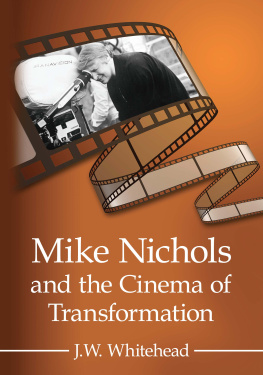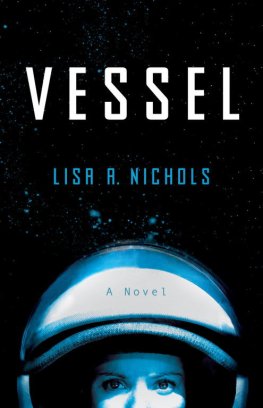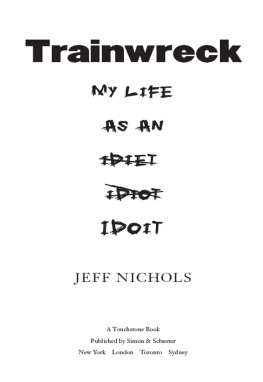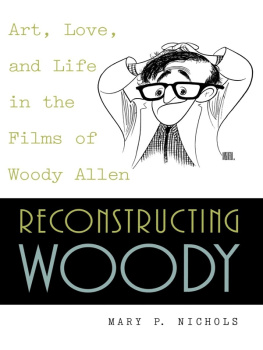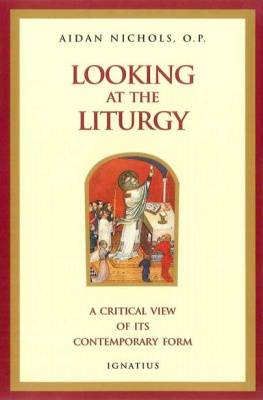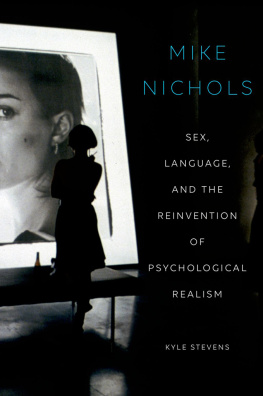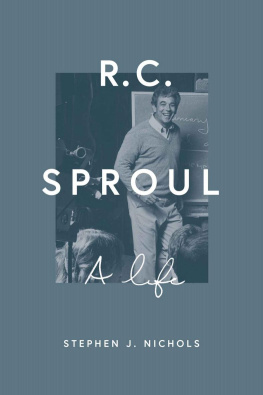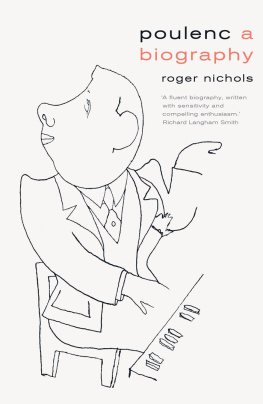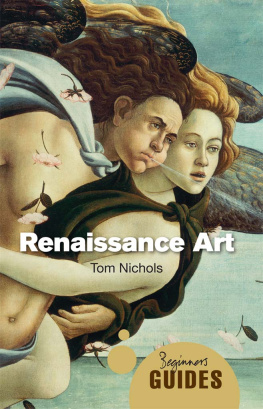
Mike Nichols and the Cinema of Transformation
J.W. WHITEHEAD

McFarland & Company, Inc., Publishers
Jefferson, North Carolina
All photographs provided by Photofest unless otherwise indicated.
LIBRARY OF CONGRESS CATALOGUING DATA ARE AVAILABLE
BRITISH LIBRARY CATALOGUING DATA ARE AVAILABLE
e-ISBN: 978-1-4766-1642-1
2014 J.W. Whitehead. All rights reserved
No part of this book may be reproduced or transmitted in any form or by any means, electronic or mechanical, including photocopying or recording, or by any information storage and retrieval system, without permission in writing from the publisher.
On the cover: director Mike Nichols on the set of Regarding Henry, 1991 (Paramount Pictures/Photofest)
McFarland & Company, Inc., Publishers
Box 611, Jefferson, North Carolina 28640
www.mcfarlandpub.com
For Kathryn and Jessica,
for my parents,
and for J. F.
Acknowledgments
While I was working on my previous book, Appraising The Graduate: The Mike Nichols Classic and Its Impact in Hollywood, some of my readers suggested that I ought to write the first book to survey Nichols entire cinematic career. The idea was daunting but irresistible, and three years later, in having completed it, Im grateful for their encouragement.
As a full-time academic, I have scant extra time to take on a book-length, five-decade retrospective project like this, so I must thank Wheeling Jesuit University for granting me a position as Scholar in Residence during the fall 2013 semester in order to complete this manuscript. Special thanks are due to Rob Phillips, who as faculty chair of the Research and Grants committee approved my application and who, having subsequently assumed the position of Chief Academic Officer, supported the configuring of my schedule for maximum leave time to research and write. Thanks also to Steve Stahl, Robs predecessor as CAO, who began the machinations that ultimately resulted in the leave time. There is no resource quite so valuable to the scholar as time. If time is the inestimable commodity, the faculty development grant I received to defray the expense of the illustrations in the text is fully calculable, and I wish to thank Wheeling Jesuit University as well for its support of faculty academic research. Thanks also to my departmental colleagues Kate, Paula, Amy, and Georgia for their cooperation and encouragement.
In the early stages of formulating this book, I was assisted by one of my most talented students, Shelby Sleevi (WJU 10), who did my preliminary literature review of the secondary critical response to Nichols films. My previous work on the book about The Graduate had prepared me for a lack of sustained scholarly dialogue about Nichols films, and Shelbys careful work confirmed my suspicions that I would have to blaze some trails in Nichols scholarship.
My research was both local and far-flung. Thanks as always to Kelly, Paula, Betty, and Barb at Wheeling Jesuit Universitys Bishop Hodges Library for helping me gather resources. I also wish to express my deep appreciation to the staff at the Edwin Fox Foundation Reading Room of the British Film Institutes Reuben Library. The British Film Institute is a mecca for film scholarship and connoisseurship; given a free day in London, I am hard-pressed to choose between the National Gallery and the BFI Southbank, which usually means that I split my day between the two sides of the Thames. Special thanks to the librarian who, on my last afternoon of my last day at BFI researching for this book, understanding my non-negotiable next-day airline ticket and the immovable forces of other researchers stationed at each of the reading rooms microfiche viewers, took pity on me, disappeared into the librarys back rooms, and returned half an hour later with copies of the pages I sought, gratis. Thanks also to Ron Mandelbaum at Photofest for helping me locate images that illustrate my argument.
I wish to express my gratitude to the West Virginia Humanities Council, a state affiliate of the National Endowment for the Humanities, which provided me financial support to defray the costs of research travel and the purchase of the twenty feature films Mike Nichols has released during his half-century in Hollywood. Having the films close at hand for reference over the two years of writing time has proven invaluable to close comparative analysis. Any views, findings, conclusions, or recommendations herein do not necessarily represent those of the West Virginia Humanities Council or the National Endowment for the Humanities.
Finally, thanks as always to my family and friends for their support. Now that Ill have some free time again, lets watch some movies.
Preface
All my pictures turn out to be all about transformation,
Not long after the box-office failure and critical static that attended his much-anticipated 1970 adaptation of Joseph Hellers novel Catch-22, Nichols would lose his way so completely in Hollywood that, for an extraordinary eight years, 19751983, he made no narrative feature films. He returned to the stage. His first play directed during his Hollywood hiatus was in 1976: David Rabes Streamers, an aggressive ensemble drama on Vietnam; by the following year, Nichols as producer had delivered the iconic musical Annie into the hearts of the populace, thus securing for himself a new fortune but further muddying what might be called an auteurist sense of Nichols the narrative artist.
Nichols would return triumphantly to Hollywood after his strange interlude of nearly a decade, his first film of a resurrected career the noble, genre-bending Silkwood (1983), which earned him his third Oscar nomination as Best Director, but as the new films piled up through the 1980s and 1990s, he was all but unrecognizable as the auteur filmmaker of the late 1960s; hed become an industry professional, cranking out entertainments within a largely anonymous stylistic sensibility that referred back for its inspiration to the work of Jean Renoir as well as to the Hollywood Golden Age of Invisible Style and assembly-line manufacture: [B]y the time that youre in the middle to late years, your technique should have burned away, Nichols says. It should be invisible. [] What is a great Renoir shot? I have no idea. I dont think there is one. He just shoots it. Its just people who happen to be alive as youre watching them doing recognizable, slightly mysterious, very enjoyable things.
Nichols long-time friend Buck Henry, who collaborated with Nichols on three of his early films, the adored The Graduate, the vilified Catch-22, and the dismissed The Day of the Dolphin, regrets Nichols weakness for seemingly safe and unchallenging material: He knows I dont like a lot of the stuff he does. I think its beneath him.
What Thomson implies in his culminating question is an expectation of auteur consistency in a film artists work, the stylistic and thematic autograph that announces we are watching a distinctive brand: the Orson Welles film, the Alfred Hitchcock film, the Robert Altman film, the Woody Allen film. These last two eminences in particular are roughly chronological contemporaries of Mike Nichols, though Altman got his start in industrial filmmaking and television, while Allens beginning were, similar to Nichols, in comic cabaret performance. Both Altman and Allen have been well scrutinized by the academic presses, while Nichols career has gone largely unexamined. Until now, the only monograph on his Hollywood career was published by H. Wayne Schuth in 1978, when Nichols was a mere decade into filmmaking. Lee Hill laments the puzzling lack of sustained critical study of Nichols career: Outside of the usual film junket type publicity, there has been little serious commentary about Nichols work. The only other book published about Nichols has been my 2011 study of his most iconic film, called
Next page
